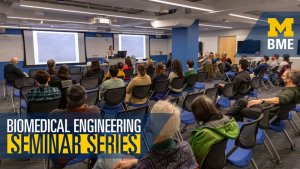Presented By: Biomedical Engineering
Biomedical Engineering Seminar Series
"When the Air We Breathe Ages Our Arteries: Mechanisms of Vascular Injury from Fire Smoke Inhalation," with Chiara Bellini, Ph.D.

When the Air We Breathe Ages Our Arteries: Mechanisms of Vascular Injury from Fire Smoke Inhalation
Abstract:
Cardiovascular aging reflects the gradual loss of vascular compliance and serves as a powerful indicator of overall cardiovascular health. Hallmarks of this process include inflammation, oxidative stress, endothelial dysfunction, and aortic stiffening, all of which compromise the ability of large arteries to regulate blood flow and pressure, increasing susceptibility to disease. Our research program seeks to uncover the molecular mechanisms that drive these functional shifts and to determine how environmental stressors accelerate vascular aging. In this seminar, I will first highlight recent findings from our work mapping the trajectory of aortic aging in mice. Using single-cell transcriptomics and mechanical testing, we identified immune cell accumulation, extracellular matrix remodeling, and altered Piezo-1 signaling as key processes that increase aortic stiffness with age. I will then discuss how chronic exposure to wildfire smoke, an increasingly common environmental hazard, can recapitulate age-associated vascular maladaptation. Through a mouse model scaled to the exposure of wildland firefighters, we demonstrated that repeated inhalation of Douglas Fir smoke induces inflammation, oxidative and nitrosative stress, endothelial dysfunction, and fibrotic remodeling of the aortic wall, leading to vascular stiffening and elevated blood pressure. Collectively, these studies frame vascular aging as a unifying lens through which to understand the cardiovascular consequences of environmental exposures and highlight pathways that may guide future prevention and intervention strategies.
Abstract:
Cardiovascular aging reflects the gradual loss of vascular compliance and serves as a powerful indicator of overall cardiovascular health. Hallmarks of this process include inflammation, oxidative stress, endothelial dysfunction, and aortic stiffening, all of which compromise the ability of large arteries to regulate blood flow and pressure, increasing susceptibility to disease. Our research program seeks to uncover the molecular mechanisms that drive these functional shifts and to determine how environmental stressors accelerate vascular aging. In this seminar, I will first highlight recent findings from our work mapping the trajectory of aortic aging in mice. Using single-cell transcriptomics and mechanical testing, we identified immune cell accumulation, extracellular matrix remodeling, and altered Piezo-1 signaling as key processes that increase aortic stiffness with age. I will then discuss how chronic exposure to wildfire smoke, an increasingly common environmental hazard, can recapitulate age-associated vascular maladaptation. Through a mouse model scaled to the exposure of wildland firefighters, we demonstrated that repeated inhalation of Douglas Fir smoke induces inflammation, oxidative and nitrosative stress, endothelial dysfunction, and fibrotic remodeling of the aortic wall, leading to vascular stiffening and elevated blood pressure. Collectively, these studies frame vascular aging as a unifying lens through which to understand the cardiovascular consequences of environmental exposures and highlight pathways that may guide future prevention and intervention strategies.